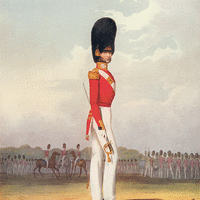More about The Apotheosis of War

Sr. Contributor
Aptly included as part of a series Vasily Vereshchagin called "The Barbarians."
Inscribed into the frame is the phrase, "This is dedicated to all great conquerors, past, present, and future. "The Apotheosis of War" was also inscribed on the frame. Really seems like Vereshchagin was one of those guys who goes to a party and over-explains why all his jokes are funny, and why all his paintings are morbidly soul-crushing.
Still, Vereshchagin genuinely believed in the power of this painting's message to proselytize for peace. While the military leaders of Europe's more pugilistic empires (we're looking at you Germany and Austria) were banning their soldiers from going to Vereshchagin's exhibitions, the artist was offering free admission to servicemen to view and digest the material. After the proscription, Vereshchagin was known to wait late at night in the alleys behind his exhibitions across Germany and Austria waiting for soldiers to walk by, whistling at them and saying, "Hey, soldier. You look like you have a clear-cut understanding of war's purpose in a modern society. Wanna see something cool?"
The work was originally going to be named after Tamerlane, the Mongol ruler of Samarkand (today known as Uzbekistan). Tamerlane controlled an empire that stretched from present day India across Asia's Steppes and into Europe. In addition to conquest, Tamerlane was into long walks on the beach, volunteering at animal shelters, and ordering giant pyramids made from the skulls of his vanquished adversaries built outside their city walls. Vereshchagin, however, eventually felt the association limited the message and went for something more ethereal.
And of course, no painting like this can escape the 20th century without becoming the cover art to a heavy metal album. This time, the cover art belongs to Rapid Force's 1993 LP "Apotheosis of War." It's like everyone involved with this painting loses their sense of subtlety. If you're into the crossroads of Russian realist paintings and the mid-90s Yugoslavian trash scene (so probably, uh, three of you maybe), then it's a must listen. It's kind of like early Megadeth meets Cézanne. Metal.
Featured Content
Here is what Wikipedia says about The Apotheosis of War
The Apotheosis of War is a mid 19th century painting by Russian war artist Vasily Vereshchagin. Following his completion of the painting, Vereshchagin dedicated his work "to all great conquerors, past, present and to come". Done in oil on canvas, the painting depicts a pile of skulls outside the walls of a city in Central Asia. It is considered part of Vereshchagin's Turkestan Series.
The painting is now displayed in the Tretyakov Gallery in Moscow.
Check out the full Wikipedia article about The Apotheosis of War

















I like this picture because of the different shapes within it. The circular skulls pile together to form a pyramid-like structure. It also seems as though the crows are flying in a single file line to the pile of skulls.